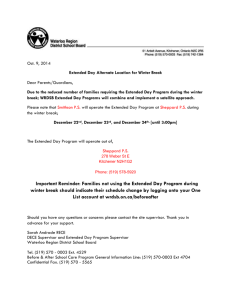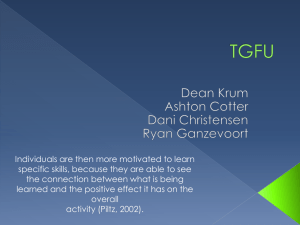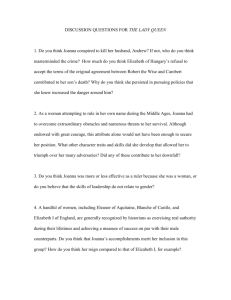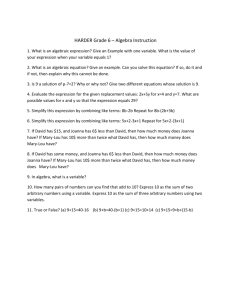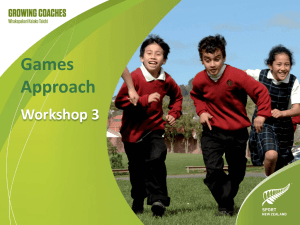TGfU Workshop Hand out.
advertisement
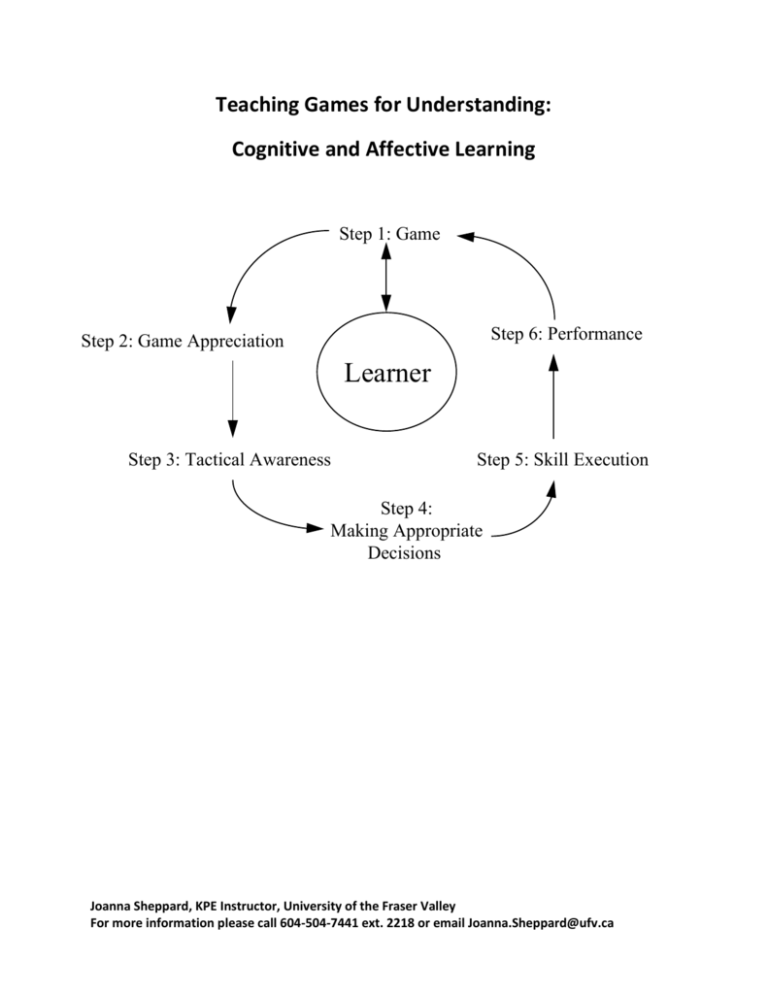
Teaching Games for Understanding: Cognitive and Affective Learning Step 1: Game Step 6: Performance Step 2: Game Appreciation Learner Step 3: Tactical Awareness Step 5: Skill Execution Step 4: Making Appropriate Decisions Joanna Sheppard, KPE Instructor, University of the Fraser Valley For more information please call 604-504-7441 ext. 2218 or email Joanna.Sheppard@ufv.ca HOW TGFU DIFFERS FROM EARLIER METHODS. Traditional methods of teaching sport and physical activity have focused on the activity itself, not on the children who participate. Researchers and educators have raised several concerns about these traditional methods: Children achieve little success Children knew little of the strategies and concepts of the games Teaching methods were inflexible Children had poor decision making abilities Children were dependent on their coaches Compared to these outcomes, TGfU has been shown to result in children who are creative, motivated, successful, and enjoy their participation in sport. TGfU changes the emphasis from focusing on factors such as technical skill development to critical understanding of the nature of the game. The main characteristics of TGfU games are that (1) they focus on the abilities and needs of the participant, and (2) they encourage development of skills and knowledge across a range of games. The TGfU approach is different from how sport skills are typically taught. In traditional training methods, the drill, or the performance is of central importance. Therefore, in TGFU it is important to understand the developmental stage of your athletes. Notes: Joanna Sheppard, KPE Instructor, University of the Fraser Valley For more information please call 604-504-7441 ext. 2218 or email Joanna.Sheppard@ufv.ca TGfU is based on a series of proven educational principles. These include: Sampling – Allowing participants to experience a wide variety of games within the same games category. In this way, learners will get a better understanding of rules and strategies that are common within a category. For example, it is common in an invasion game to have a situation in which two offensive players play against one defensive player. A basketball teachcould have his or her players’ practice 2 on 1 situation while playing handball, soccer, or rugby. Game representation – Sometimes learners are not capable of playing a full formal game (i.e., according to the complete rules). Teacherscan set up simplified game-like scenarios that are more appropriate for their level of development. For example, when teaching baseball, teachersmay have batters stop at first base after getting a hit. In the formal game, players may choose to run on to second base. But by forcing them to stop at first, teacherscan stress the relationship between hitting the ball and making it safely to first base. Exaggeration – Teacherscan choose to emphasize a particular aspect of a game. This would help learners understand basic tactics. For example, in an invasion game such as soccer or rugby, teachers could have children play on an extra-wide field. This will help children learn how to use space to make better passes. Developmental progression – It helps participants to learn the skills and tactics of a game if teachersprogress from simpler to more complex games. For example, when using TGFU to teach volleyball, athletes may play in progressions from 2 vs. 1, to 3 vs. 2, to 4 vs. 4, to full games of 6 vs. 6. Notes: Joanna Sheppard, KPE Instructor, University of the Fraser Valley For more information please call 604-504-7441 ext. 2218 or email Joanna.Sheppard@ufv.ca HOW DO YOU USE TGFU IN YOUR PHYSICAL EDUCATION TEACHING? TGfU activities follow a six step process This process focuses on learning and performing sport skills in a variety of contexts. The athletes are the focal point of each step. Through the model, athletes will actively be involved in developing their skill execution answering questions from the teachers as they are involved within the first games. Therefore, by the time the athletes develop their skills, they understand the significance of this practice. Skill execution and performance occur at the end of these steps. The final outcome is athletes who possess a strong knowledge of the game and their own abilities. These athletes can then participate in a wide variety of games. Steps 1. Game – learning begins with playing the game. Teachers should have a good understanding of the developmental stage of their athletes and introduce a modified version of the game. The game should still have a clear objective, and follow the basic rules and concepts of the formal game. Example: The sport of basketball could be introduced to new players by modifying the game in a number of ways. For example, instead of having to dribble the ball, players can run or walk with it for a certain number of steps. Also, instead of having to shoot the ball into an overhead basket, there could be an easier target (e.g., a teammate standing in a safe zone). 2. Game Appreciation – after playing in the game, athletes will develop an appreciation for how the rules of the game interact with strategy and participants’ abilities. Example: After playing in the modified basketball game from #1, athletes should begin to recognize certain relationships between the rules and skills. For example, it takes a different kind of motion to pass it to someone who is close, than to someone who is far away. 3. Tactical Awareness – by being involved in game like scenarios, athletes will understand basic offensive and defensive tactics. Example: From the basketball example, a basic offensive tactic that could be recognized is for a player to move when his/her teammate has the ball so that he/she can get open to receive a pass. For defensive tactics, they may recognize how important it is to stay close to the player they are guarding at all times. Joanna Sheppard, KPE Instructor, University of the Fraser Valley For more information please call 604-504-7441 ext. 2218 or email Joanna.Sheppard@ufv.ca 4. Making Appropriate Decisions – Learners begin to apply the knowledge they have learned through previous steps to execute properly during game situations. Example: Players can learn when it is better to pass the ball than to keep possession and move with it, or vice versa. Teachers Involvement: Stop play at situations when participants should be making this decision. Ask them what the ball carrier’s options are and the pros and cons of each. 5. Skills Execution – at this point, the athlete will have a context within which he or she can begin to attempt proper skill executions. Also, they should have a complete enough understanding of the game and tactics so that they can begin to recognize their own mistakes and attempt to correct them. Example: Players can recognize the need for different skills for different types of passes and shots. Teachers Involvement: Move around your athletes as they are practising the specific skills and provide positive and critical feedback. 6. Game Performance – the final step is to apply what has been learned in more advanced forms of the game, leading up to the “official” game, with all rules formally applied. Teachers should be actively involved in game play, particularly by giving feedback to participants. Example: Games can be progressively changed to be more like basketball. Introduce dribbling, have games of 3 on 2 and 4 on 3 until having a full court game of 5 on 5. Teachers Involvement: Provide feedback during play specifically based on what was worked on in that practice. For a FREE TGfU Games Resource, go to www.playsport.net Joanna Sheppard, KPE Instructor, University of the Fraser Valley For more information please call 604-504-7441 ext. 2218 or email Joanna.Sheppard@ufv.ca Target-Type Games Emphasize accuracy and control. Modify challenges by changing target size, distance and equipment, by using stationary or mobile targets and by having the players shoot while stationary or mobile (e.g., croquet, golf, archery, curling, bowling) Tactical Goal Aim & accuracy Protect target Description To deliver an object towards a target with the right amount of force to successfully reach the intended target. To place obstacles in the way to make it difficult for the opposition to hit the target. Level of Complexity 1 – Low level 4 – High level Net/ Wall-Type Games Net/wall-type games involve moving and controlling an object and hitting it within a specified space. Players work to make it difficult for other players to gain possession of the object or to send it back to the wall or across the net. Small numbers of players are usually involved in net/wall games (e.g., tennis, 4square, badminton, table tennis, volleyball) Tactical Goal Description Consistency To be able to continually return the ball back over the net or to the wall so that it lands in play. Setting up for Attack To place the ball in vulnerable spots on an opponent’s court (e.g., sides, front, back) so they are out of position and space is created on their court to win the next shot. To position oneself or team on the court in order to be able to cover as much space as possible. Ready position Level of Complexity 1 – Low level 3 – Medium level 3 – Medium level Joanna Sheppard, KPE Instructor, University of the Fraser Valley For more information please call 604-504-7441 ext. 2218 or email Joanna.Sheppard@ufv.ca Striking/ Fielding-Type Games Striking/fielding-type games can involve running, striking, throwing, kicking and catching. Runners hit, kick or throw an object then score runs by running to designated areas. Fielders retrieve the object and get it to a specified place to stop runs from being scored and to get opponents out. Because of the many aspects of the game, strategy for striking/fielding games can be challenging (e.g., baseball, cricket, rounders, softball) Tactical Goal Accurately Hit Ball Description To use proper striking mechanics (e.g., “keeping an eye on the ball”, correct grip) to hit the ball into the field of play. Level of Complexity 1 – Low level Placement Away from Fielders To hit the ball over or around the fielding team into open or safe areas. 2 – Low level Covering Space To work together with the fielding team to cover as much space as possible. 3 – Medium level Score Runs To use tactical solutions such as advancing runners so they are closer to the scoring area or hitting the ball away from the fielding team. 3 – Medium level Avoid Getting Out To use tactical solutions such as quickly running to a safe area (e.g., base) before the fielding team is able to throw to the safe area or tag the runner. 4 – Medium level Stop Scoring Runs: To work together as a defending team to prevent scoring by the offense. Examples include covering as much area as possible and throwing the ball to a teammate who is able to prevent the runner from scoring. 5 – High level Joanna Sheppard, KPE Instructor, University of the Fraser Valley For more information please call 604-504-7441 ext. 2218 or email Joanna.Sheppard@ufv.ca Invasion/Territory-Type Games: Invasion/territory-type games involve controlling an object, keeping it away from opponents and moving it into a scoring position to score on a target. Games can be modified to be simple running games or to use a specified skill (kicking, throwing) (e.g., soccer, handball, ultimate Frisbee, football, basketball, lacrosse, field hockey). Tactical Goal Description Maintain Possession: When the team on offence has possession of the object (e.g., puck, ring, ball). To defend the goal or goal line, as a team or as an individual, by stopping other players or stopping the object. To use various locomotion skills (e.g., dodging) or retaining skills (e.g., dribbling) to avoid being caught by a defending player. To pull a defender away to create an open area for a teammate to move through or to pass an object into an open space. To work together as a team to cover areas on a court/ field to make it difficult for the team on offence to get close to the defending team's goal. When in possession of the object, to put pressure on the other teams goal by shooting or passing the object at or towards the goal or goal line. Pre-designed movements used by a team when an object is put back into play (e.g., corner kick in soccer, face-off in ice hockey). To use legal skills to get an object away from an opponent or to anticipate a pass in order to intercept it. Defend Goal: Avoid Defense: Create Space: Defend Space: Attack Goal: Set Plays: Regain Possession: Level of Complexity 1 – Low level 4 – High level 2 – Medium level 4 – High level 5 – High level 4 – High level 5 – High Level 3 – Medium Level Joanna Sheppard, KPE Instructor, University of the Fraser Valley For more information please call 604-504-7441 ext. 2218 or email Joanna.Sheppard@ufv.ca Life Skills Development Life Skills are defined as a set of skills that people use to effectively deal with life challenges. Life challenges for children and youth can include making informed decisions about alcohol, tobacco, and other substances, learning the importance of healthy relationships, physical fitness, nutrition and peaceful conflict resolution. It can also help reduce negative social learning such as delinquent behavior, risky sexual behavior, peer rejection and emotional disorders. However, simply telling children that it is right to make healthy choices is not enough to ensure that they will do so. Teaching Life Skills cannot only benefit the individual but can create a healthier community. Practicing Life Skills leads to positive results. Learning by doing is the most effective method of learning, therefore why teaching Life Skills through physical education and sport can be an effective way to foster healthy development. Life Skills can be grouped into three categories as suggested by UNICEF Communication and Interpersonal Skills Decision Making and Critical Thinking Skills Coping and Self Management Skills Communication and Interpersonal Skills focus on areas such as developing skills in communication, negotiation, refusal, empathy, cooperation and teamwork and advocacy. Examples of implementing questions into the activity: What are different ways to communicate? How can this activity foster the development of making healthy choices? How does this activity help to foster a better understanding of individual differences and similarities? How do different communication strategies work in different situations? Were there obstacles during the activity? How did you respond? What are other obstacles that we are faced with in daily living? What leadership skills emerged during this activity? What are skills a leader should have? When would it be important to learn to follow? What other skills did you use in this activity? Joanna Sheppard, KPE Instructor, University of the Fraser Valley For more information please call 604-504-7441 ext. 2218 or email Joanna.Sheppard@ufv.ca Decision Making and Critical Thinking Skills involve students creatively and critically examining a problem and making decisions that not only positively benefit themselves, but others and their environment in a way that does not harm others in the process. Examples of implementing questions into the activity: What helped you and/or your team succeed? When is it better to have the group collectively make one decision and when is it best to make an individual decision? Is there ever a time where you made a decision based on pressure from your friends? What impact did it have on others? Your environment? What were the different roles individuals played in the game? Were the roles determined equally in a way that included everyone? Coping and Self Management Skills include developing skills for increasing internal locus of control, managing feelings and managing of stress. Examples of implementing questions into the activity: How does trying one's best help foster internal motivation? Why is challenge important? Why is it important to challenge yourself in school? In social situations? In making healthy decisions on nutrition and physical activity? What are positive ways of dealing with frustrations and managing stress? How does providing choice in the activity foster creative thinking? When is it appropriate to take risks? Why do you think it is important to know when taking a risk is worth helping someone else out? How does being active help you and others around you feel better? Are there times when being active does not make you or others around you feel better? What are ways that you can help others feel better while being active? Joanna Sheppard, KPE Instructor, University of the Fraser Valley For more information please call 604-504-7441 ext. 2218 or email Joanna.Sheppard@ufv.ca

